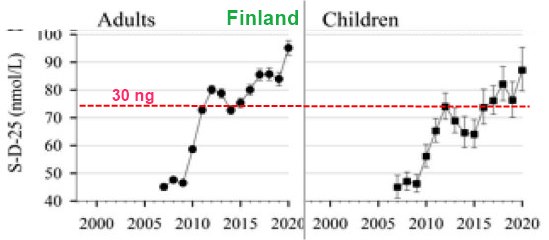Arctic school children in Russia: only 1 in 11 has more than 30 ng of Vitamin D
Low vitamin D levels among children and adolescents in an Arctic population
https://doi.org/10.1177/14034948221092287 behind $41 paywall
Svetlana Malyavskaya, Galina Kostrova , Alexander V. Kudryavtsev, ...

Aims:
We aimed to study the vitamin D status of the population of Arkhangelsk, a city in northwestern Russia.
Methods:
A cross-sectional study was conducted to estimate serum 25(OH)D concentrations in Arkhangelsk residents, including 55 neonates and their mothers, 214 children <3 years, 191 schoolchildren (7–8 years), 403 adolescents (13–17 years), 260 university students (18–22 years) and 85 adults (24–60 years). The data were collected from March 2013 to November 2014 and from January 2016 to May 2016
Results:
Normal levels of 25(OH)D (>30 ng/ml) were found in 5% of neonates, 43% of their mothers, 43% of children <3 years, 9% of schoolchildren, 1% of adolescents, 17% of students and 26% of adults. There was a moderate positive correlation (rs = 0.563, p = 0.001) between 25(OH)D levels in mother’s blood and umbilical cord blood.
Conclusions:
Vitamin D deficiency is highly prevalent in the population of Arkhangelsk, particularly in neonates, schoolchildren and adolescents.
Vitamin D Life studies in both categories Far from Equator and Infant-Child
This list is automatically updated
{category}
Vitamin D Life - Overview of Rickets and vitamin D contains
{include}
Perhaps half of Russian children have rickets, 500 IU vitamin D was not enough – June 2013
Vitamin D Life - After years of vitamin D fortification and supplementation, Finland has 38 ng levels - March 2022

It appears that children in Finland are 7X more likely to have good vitamin D levels than children at same latittude in Russia
